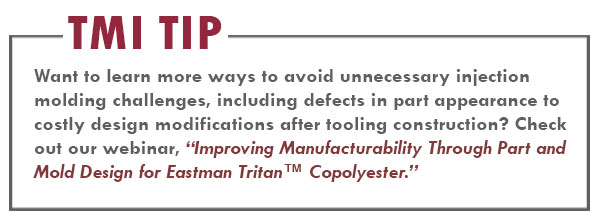4 Keys to Successful Tooling Design
To develop successful injection molding applications, it’s crucial to consider all aspects of design early on in the process. Tooling design review is an important step in helping to determine what type of gating system and other factors are the right fit for your device.
Here are four tooling design tips for injection molding with Eastman TritanTM copolyester:
Proper gating selection
Here are four tooling design tips for injection molding with Eastman TritanTM copolyester:
Proper gating selection
- Most conventional cold gating styles work well with TritanTM copolyesters, including sub, pin, fan, edge, sprue, and diaphragm gates. Self-degating gate styles, such as sub gates or pin gates, typically require smaller gate sizes balancing the ability to limit pressure drop with degating.
- For hot runner systems, valve gates should be used. Critical design features of TritanTM valve gate systems include thermal control and independent water supply.
- Tritan™ copolyesters require good thermal control throughout the cavity for optimal processing.
- Injection molding gates typically have the highest heat load in an injection mold.
- Higher thermal conductivity steels allow greater heat transfer rates, potentially reducing cycle time and providing a more uniform cavity temperature.
- The inability to remove air from the cavity can result in part appearance defects such as incomplete fill (or short shots) and burn marks due to heat of compression of the escaping air.
- Suggested vent depths for Tritan™ copolyesters are typically 0.0005′′–0.0015′′.
- Parts should be adequately supported during ejection to avoid part deformation/breakage.
- Part design features like long cores or deep ribs with minimal draft can result in high forces being placed on the molded part during this process.
- Tritan™ copolyesters have a relatively low modulus (i.e. are more flexible) and yield strength compared to some competitive transparent resins. Contact us today.






 Close
Close


